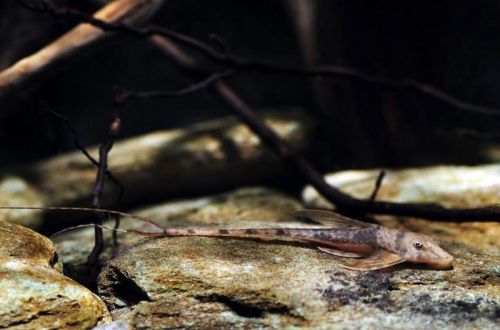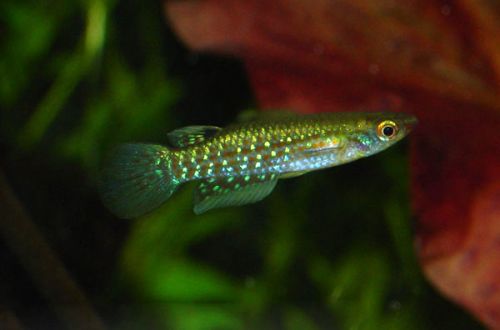
Pterolebias zonatus
Pterolebias zonatus, scientific name Pterolebias zonatus, belongs to the family Rivulidae (Rivulaceae). An annual fish from the Orinoco Basin in South America, whose lifespan is limited to the interval between the rainy season and the onset of the dry period. Lives in temporary reservoirs in conditions that will seem unfavorable for most fish. For this reason, it is considered a hardy and unpretentious species. Occasionally found in home aquariums.

Habitat
As noted above, fish live in small reservoirs, which are formed as a result of river flooding during the rainy season and flooding of vast areas. The reservoir is a small puddle well lit by the sun with dense aquatic vegetation or located in the shade of trees in the rainforest litter. The soil, as a rule, consists of mud, clay, silt. The water is muddy.
Description
Adults reach a length of up to 10 cm. The fish got their name “zonatus” due to the numerous vertical stripes, contrasting color zones, on the body. The main color in the color is turquoise, greenish or blue. The stripes are dark burgundy. Females have a similar body pattern and coloration, but the colors are less saturated. Males have very large fins relative to body size.

In the wild, the lifespan of Pterolebias zonatus is about 6–7 months. During this time, they rapidly go through all stages from fry to adult fish. In home aquariums, they can live for more than a year.
The fish has a close relative – Pterolebias Orinoco, often living in the same reservoirs. It has a similar size and color, but there are no characteristic stripes in the pattern.
Behavior and Compatibility
Peaceful moving fish. Although males compete for the attention of females, it does not come to aggression. It is recommended to keep in mixed groups with several males and females.
Compatible with other species of comparable size including Killie fish.
Brief information:
- The volume of the aquarium – from 50 liters.
- Temperature – 20-24°C
- Value pH — 6.5–7.5
- Water hardness – soft (5-8 dGH)
- Substrate type – soft
- Lighting – any
- Brackish water – no
- Water movement – little or no
- The size of the fish is about 11 cm.
- Nutrition – foods high in protein
- Temperament – peaceful
- Content in groups
- Life expectancy about 1 year
Keeping and breeding in aquariums
The optimal size of the aquarium for a group of 3-4 fish starts from 50 liters. Arrangement is arbitrary. However, given the short life span, the purpose of keeping should be breeding for new offspring.

In nature, fish lay eggs in the thickness of soft soil, plunging into it for a while. Thus, the eggs remain in the soil layer after the reservoir dries up, waiting for the start of the rainy season. Diapause can reach 6-7 months.
For the development of eggs, a mandatory step is a temporary extraction from the water. For these purposes, in the aquarium it is necessary to use substrates that are easy to get. For example, coconut fiber or a layer of aquatic ferns and mosses can become such soil, which it will not be a pity to remove and dry.
A comfortable environment for keeping is soft acidic water with a temperature of 20 ° C – 24 ° C. A similar temperature is maintained until the onset of sexual maturity of the fish, i.e., the first 5–6 months. Spawning is stimulated by a gradual increase in temperature to 28–33°C.
Aquarium equipment includes a heater, lighting system and a simple airlift filter.
A prerequisite for successful spawning is a balanced diet. The basis of the diet should be frozen or live foods, such as bloodworms, daphnia, brine shrimp, mosquito larvae, etc.
If breeding is not planned, then the temperature should not be raised. It speeds up the metabolism of fish and shortens their lifespan.
When the fish lay eggs, the substrate is removed. The most difficult thing is to remove organic waste, which can later cause mold. The substrate should be washed very carefully in the same water from the aquarium. The slightly damp substrate is placed in a container with a perforated lid. The degree of humidity is determined experimentally and depends on many factors.
If the washing and storage procedure was successful, then after 6 months the substrate can be placed in water and fry can be expected.





